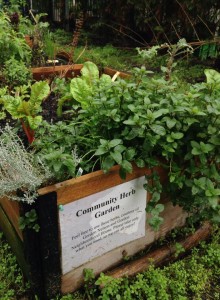Today, Team 17 learned that best-laid plans rarely interact well with real world issues. Or to put it in LFS terms, Community-Based Experiential Learning involves a lot of change as stakeholders and project team members collaborate. We took our preconceived notions and research questions, turned them upside down and inside-out, then built a new idea before realizing it was the same as our old idea and collapsing in a confused heap. I’m pretty sure Professor Jovel and Will would be proud of us.
The end result, though, is something we’re happy with. We’ve incorporated a stakeholder’s perspective into our research and waded through a sea of confusion to find something worth studying. As Derrick put it after the interview:
“I feel really good about this project. We’re promoting food security, but through community building and engagement instead of food access.”
It started out pretty simply.
We met Stephanie, Billy Jo, and Boris (property managers with GNI) at the door of 1075 Burnaby Street (an apartment building managed by GNI and the site of the Herb Garden) and conducted a brief 15 minute interview.
Stephanie described a brief history of her experience with GNH, the process of building the Herb Garden, and her current experiences with it. We talked about her recommendations for the garden, observations about visitors, and her involvement. Pretty standard for an interview.
We even ran into a stroke of luck in that Stephanie had hired Chris Reid of Shifting Growth to build the herb garden. We’re planning on reaching out to Chris and we’ll hopefully get a lot of insight into making a community garden.
However, when the team got together to discuss what the interview meant for our project, we realized that our previous ideas about what we could do for the Herb Garden and what it needed could use a bit of work.
Our original idea was to assess the Herb Garden’s efficacy (how useful it’s being) by interviewing or surveying tenants and community members about any shifts in their food preparation and consumption. It would be simple, it would answer questions about food security, and it served all the main goals of GNH.
After discussion, we realized that Stephanie’s main concern with the Herb Garden wasn’t whether it was improving the food literacy or health of community members, but whether or not it was bringing the community members together.
Although the initial response had been quite positive and people had been excited about the Herb Garden, it hadn’t exactly gotten people “out on Sunday afternoons, picking herbs and gardening”, as Stephanie put it.
Had we considered this at all in our first research question? Not really. We were concerned with food security, with changing food habits with food accessories, not by feeding them. We were encouraging home cooking and food literacy and championing the cause of food security! But this community aspect was still rather important.
We could’ve proceeded with our original plan. We could’ve only asked about if people were cooking with herbs and spices. Our original plan was still viable. But that wasn’t what our stakeholders needed.
So we asked some questions.
- What’s the role of a Herb Farm?
- What’s the role of a community garden?
- What’s the difference?
- What are the benefits?
- Does community play a role in this?
It got confusing rather quickly. We asked each other: “Can a herb garden even promote community? People don’t do much gardening there! The herbs are just there and then they’re taken! How do we measure community?”
But our previous ideas of food literacy were looking a little bare if not many people visited the Herb Garden. Was that really what the Herb Garden could do best? Was that really the best question we could ask?
An anonymous team member put it best:
I feel like we’re questioning the whole system!
As I said, our professors would be proud.
Luckily, questions are fertile ground for ideas, so we managed to pull something together.
- We wanted to know if this herb garden had benefits to the community and for food literacy
- We wanted to know if community gardens usually did this and how previous researchers had observed these effects.
The end result? Well, we’re shy people and we’d rather not put it into a sentence as assertive as a research question. Instead we decided that we were going to compare this herb garden to other case studies of community gardens. Can a herb garden build community like a community garden can? Is it doing it right now? How?
Our research approach could use some fine-tuning, but we’re meeting with Susanna on Friday, and hopefully we’ll get some answers. We’re also going to email Andrew for some guidance.
The most important question is the one that we’re all striving towards. We haven’t acknowledged it out loud, but we’re getting closer every day and we’re confident about the answer.
Can we make a difference here?


